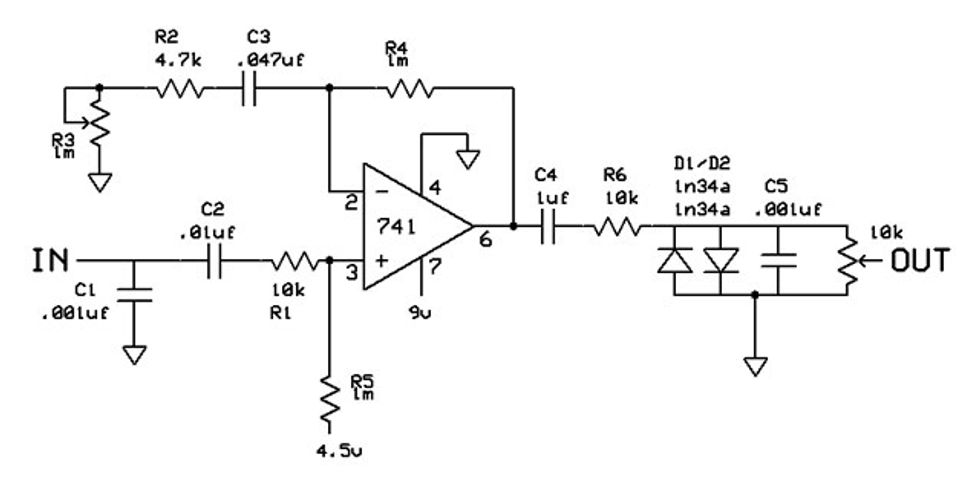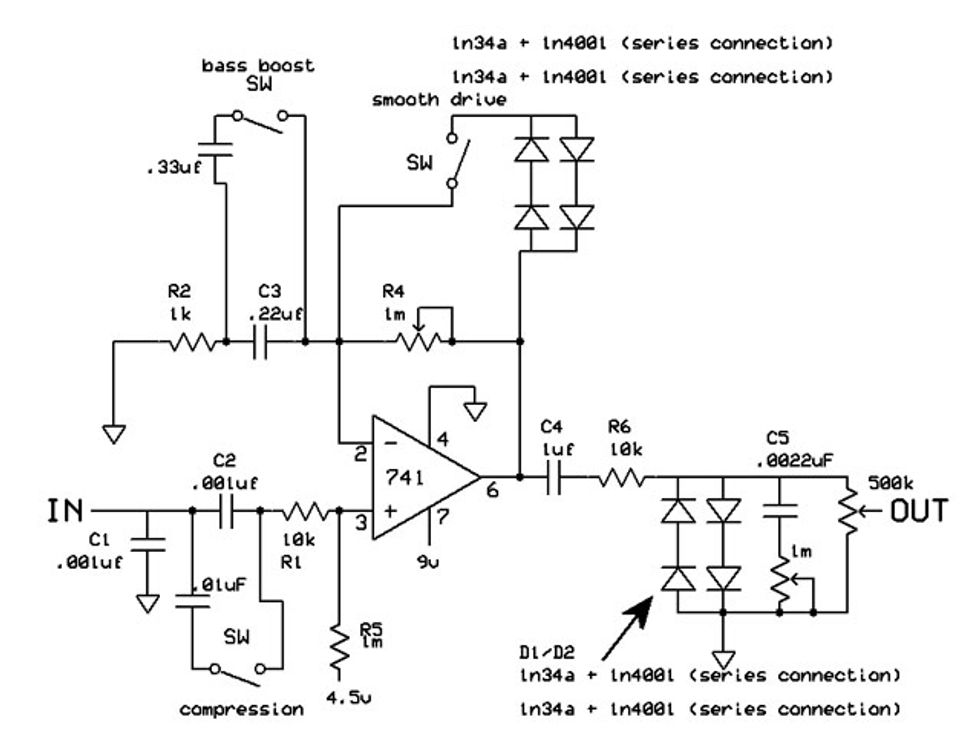Many years ago distortion pedals were much more limited than they are today. MXR released a simple hard clipping device called the “Distortion Plus” in the late seventies. Randy Rhoads, among others, used this pedal to achieve more distortion in his amps. Guitarists everywhere mistakenly thought that this little device was the secret to Randy’s tone. Since then, there have been many, many different versions of this type of circuit. Let’s take a look at it a bit closer; there are a great many mods that can be done to turn it into a tone monster.
Here''s the stock circuit:
R4, C3, R2, and R3 control the gain and frequencies getting boosted and clipped in a traditional “non-inverting” method of opamp circuit. R3 is labeled as a gain control, however you’ll notice that it changes the tonality depending on its setting. This is because it is changing the frequency response of the opamp at the same time. With the gain control all the way up it only clips frequencies 723hz and higher, though it is at max gain. In its minimum gain setting it is boosting and clipping almost all frequencies (3.4hz and higher) though it has much less gain. This is why it sounds muddy and undefined when the the gain is lower and why it thins out when you turn the gain up.
After the signal is boosted it exits through C4 and then through R6. D1 and D2 clip the signal using a “hard clipping” method while C5 works with R6 as a low pass filter to filter out 6db worth of frequencies 15.9khz and above, which the human ear can’t really distinguish too much. Most likely this was to filter out some odd harmonic overtones and/or noise. A much better use would be to wire a 100k pot in series with a .0022uF cap in place of C5. This will act as a tone control.
D1 and D2 are 1n34a type Germanium diodes in the stock version. This leads itself to a bit of a fuzzy compressed tone with not much volume left over after being clipped.
The signal exits via the 10k pot on the output.
The Dod OD250 and YJM308 circuits are almost identical to this and these mods will work for these pedals as well.
Here some of my favorite mods that I like to make to this type of circuit:
- Use an SPST switch to insert a .01uf cap in parallel with a .001uf cap in place of C2. This will give a ''more/less compression'' type of function, or a ''smooth/open'' tonality. For a more dramatic effect, make the .01uf a .047uf or so.
- Add an SPST switch around C3 to add more bass by adding a .33uf cap in parallel with C3.
- Change R2 and C3 to a 1k/.22uf for the same high gain frequency response but more gain potential
- Change R4 to a 1m audio taper pot for better response through gain adjustment.
- Add an SPST switch to add in diodes in parallel with R4. I have 1n34a and 1n4001 diodes shown here, though any can be used.
- Change D1 and D2 to 1n34a and 1n4001 diodes (in series) in place of each stock diode for louder output as well as better dynamics.
- Change C5 to a .0022uf and wired in series with a 1m audio taper pot to act as a tone control.

These mods will make your pedal into a much bigger, fuller, nicer (or meaner) sounding distortion or overdrive. While not all of the mods are necessary, I encourage you to experiment to find what you like and don’t like and tailor your own pedal to your needs.
Happy Soldering!
Brian Wampler is an author, effects designer/builder and operates IndyGuitarist Custom Effects (indyguitarist.com and wamplerpedals.com). His books include How to Build Effect Pedals, How to Modify Effect Pedals, and Advanced DIY Effect Pedals available at indyguitarist.com.






![Rig Rundown: Russian Circles’ Mike Sullivan [2025]](https://www.premierguitar.com/media-library/youtube.jpg?id=62303631&width=1245&height=700&quality=70&coordinates=0%2C0%2C0%2C0)


























